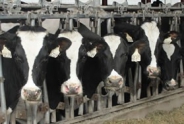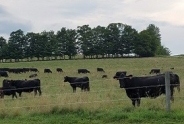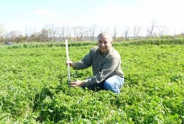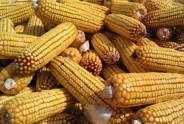Field Crop Update, August 25, 2022
Erik Smith, Area Field Crop Specialist/Team Leader
Central New York Dairy and Field Crops
1. Field Observations
Coming soon to a field near you: Corn Silage Harvest 2021
And just like that, our recent warm spell has led to our GDD accumulations since planting date to reach or exceed the 15-yr normal and have given us near-record GDD since silking dates between July 22-26! So if you are in one of the warmer areas (northern Madison Co and Saratoga Co) and you're planning on chopping short-season corn that silked on or before July 19th, your whole-plant dry matter may reach 35% as early as this weekend, and those chopping longer maturity corn that silked on or before July 19th may be ready to chop by this time next week. So get out there and check on your crop's conditions. See the GDD table in section 2 for more detailed info for your area.
As for field conditions, it's been mixed. I saw many folks making hay this week while others need to wait until next week. The forecast calls for more hot weather through Monday, with milder, drier weather in the forecast for the rest of next week. If you can wait, it may pay off. But if you're already late, get out there as soon as you possibly can in order to cut down those weeds before they set seed. That act alone will pay off next year….
Spring grains are still being harvested, though the rains have obviously made for some difficult conditions with regards to not only ruts, but weeds and increased grain moisture.
With fall approaching, be mindful of avg first killing frost date in your area with regards to your cover crops and late-summer seedings. The window to plant alfalfa (no later than 6 weeks before the first killing frost) is closing fast, if it's not already too late in your area.
Click to see the latest Oneida County Scouting Report, Northwest NY Crop Alert, Capital Area Ag Report, and New York State IPM Weekly Field Crops Pest Report.
2. Growing Degree Days (GDD) for planting date and silking date (Climate Smart Farming Growing Degree Day Calculator)
GDD are calculated by taking the average daily temperature and subtracting the base temperature for development of a given organism ((High + Low)/2 - base temp = GDD). For corn silage, we are using base 50/86, as corn development starts at 50F and ceases above 86F. Silage corn needs 750-800 GDD (depending on hybrid maturity) after silking to reach a whole plant DM of 32%. Remember that we can expect to accumulate 20-25 GDD per day, or even up to 30, so this is not a large window. Under typical late season dry down conditions we can expect the crop to reach 35% DM four to seven days later. Check your crop to see how close you may be to harvest:
Blue: Call your backup and make your plans (you will be at 35% DM anywhere between 5 - 11 days from now)
Green: Gas up the harvester and the trucks (you're chopping in 2 - 8 days)
Yellow: See you in the field
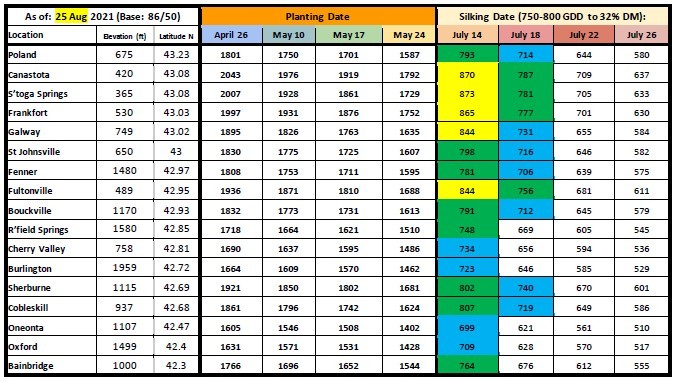
Not everyone planted their corn on one of the planting dates or in one of the locations I have listed, so this chart shows the estimated GDD for each location on each potential planting date in between (based on the actual GDD on those four dates). The locations are ordered top-to-bottom from lowest elevation to highest (the number after the location name is the elevation in feet above sea level). So if your farm is near one of the locations on this list but there's a location here that more closely matches your elevation, try that instead. You can find GDDs for your own specific location and planting date using the Climate Smart Farming CSF Growing Degree Day Calculator, but for those who might have more difficulty using that tool, maybe this chart can help.
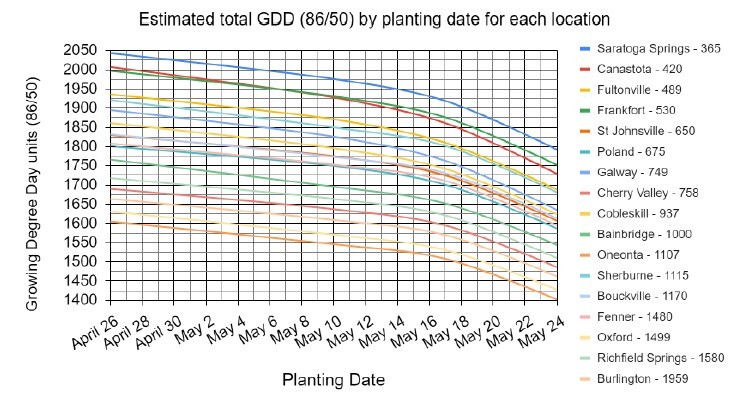
As we get closer to silage harvest, remember that silage corn needs 750-800 GDD after silking to reach a whole plant DM of 32% (depending on hybrid maturity). Under typical late season dry down conditions we can expect the crop to reach 35% DM four to seven days later. When using this chart, remember that actual GDD were calculated for July 14, 18, 22, and 26 silking dates. Dates in-between those four dates are estimates. As always, remember that GDD estimates are good for getting you in the ballpark, but are no substitute for actual conditions in the field.
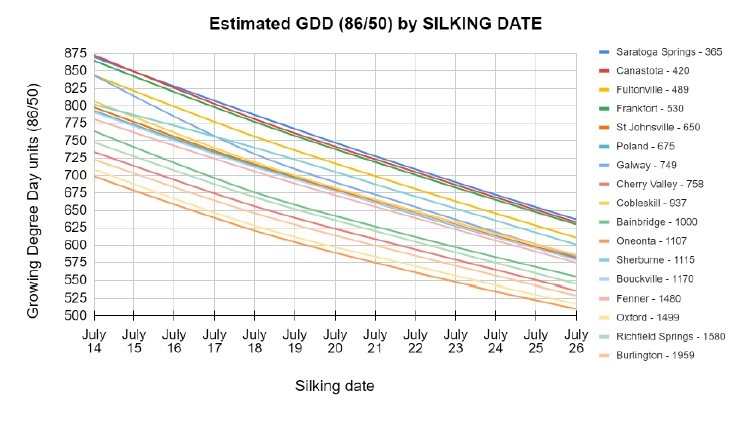
3. Pest Monitoring
The western bean cutworm traps were empty this week, so that's a wrap for this season's monitoring chart. I did not see any egg masses, but that doesn't mean they didn't do their damage - which should be evident now or in the coming weeks. Of course, let me know if you suspect your crop has an outbreak of this or any other earworm.
Fall armyworm larvae are showing up in my sweep net, so keep an eye on your sweet corn and organic corn crops.
Leafhoppers in alfalfa are still very low, while pea aphids have seen a recent surge. But so far nothing approaching threshold.
Check out Potato Leafhopper Scouting and IPM Thresholds in Alfalfa (VIDEO)
I still have yet to see any soybean white mold, but I'm expecting to see quite a bit over the next month. I have seen some various other soybean fungi in patches, mostly associated with wet spots in fields, which of course are prevalent this year. Due to this, it will be especially important to rotate these fields into another crop next year.
I will also be reaching out to some of you for my upcoming soybean cyst nematode (SCN) soil-sampling program in another month or so. We know it's just about everywhere in NY by now, but knowing the SCN population number in your fields is essential to making sound management decisions. So stay tuned.
Have a good rest of the week, and have good weekend!
Field Crop Update, August 25, 2022 (pdf; 555KB)
Upcoming Events
Labor Roadshow IX
December 1, 2025
December 9 - December 10, 2025December 17 - December 18, 2025December 22, 2025
In-person and online events to keep NY's agricultural employers informed and prepared for today's labor challenges.
Inspired by Annie's: How to Be a Strong Woman Farm Manager
December 10, 2025
December 17, 2025
Free webinars geared towards women who own or operate a farm in NYS.
2026 Dairy Day
January 13, 2026 : Dairy Day - Hamilton
Hamilton, NY
Lunch included
January 14, 2026 : Dairy Day - Ballston Spa
Ballston Spa, NY
Lunch included
Announcements
Statewide Field Crop Pathology Needs Assessment Survey
Your input is wanted for identifying priorities!Sign Up for Our Weekly E-Newsletter
We send out a bi-weekly e-newsletter that has announcements, upcoming programs, and opportunities for you! Registration is quick, easy, and free. Click here to sign up today!Farmers Can Join MeatSuite For Free!
MeatSuite.com is a free resource provided by Cornell University where NY meat farmers can create a farm profile and list their bulk (wholes, halves, quarters) and bundled (i.e. Grilling Bundle) meat products.Why should farmers join?
1. It's free and easy!
2. Connect with more local customers. In the past year the MeatSuite.com farm directory had 8,300 visits from New York consumers. Farm profiles get as many as 25 views per month from potential local customers. We also spotlight MeatSuite farms on social media and bring attention and purchases to farms through highlights and giveaways.
How do I join?
Farmers can visit https://www.meatsuite.com/farmers/ to create a free farm profile. You must list at least one product for your farm's profile to go live. You'll also have access to Cornell's free Meat Price Calculator, a helpful tool for pricing your meat to make a profit.
While you're on MeatSuite, check out the "Creating Consumer-Friendly Bulk Meats" publication on the log-in page. It has tips on how to create bulk meat products that are easier for first-time buyers to say "yes" to.
If you have any questions as you create your farm profile or products, we're here to help! Please email Matt LeRoux at mnl28@cornell.edu.

